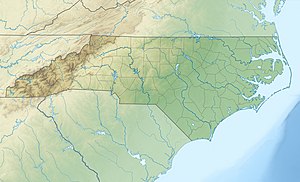Currituck National Wildlife Refuge
| Currituck National Wildlife Refuge | |
|---|---|
IUCN category IV (habitat/species management area) | |
| Location | Currituck County, North Carolina, United States |
| Nearest city | Knotts Island, North Carolina |
| Coordinates | 36°28′06″N 75°51′24″W / 36.4683°N 75.8566°W |
| Area | 8,316 acres (33.65 km2) |
| Established | 1984 |
| Governing body | U.S. Fish and Wildlife Service |
| Website | Currituck National Wildlife Refuge |
Currituck National Wildlife Refuge (waterfowl and to protect endangered species such as piping plover, sea turtles, and seabeach amaranth.

Habitat types common to most barrier islands are found on the refuge. Moving westward from the
cynosuroides
).
Various types of
shorebirds, waterfowl, raptors, mammals (including feral horses), reptiles, and amphibians common to the eastern United States, are found on the refuge. The endangered piping plover and loggerhead sea turtle
sometimes nest on refuge beaches and dunes.
The refuge has a surface area of 8,316 acres (33.65 km2).[4]
Climate
According to the
plant hardiness zone in Currituck National Wildlife Refuge is 8a with an average annual extreme minimum air temperature of 14.2 °F (-9.9 °C).[5] The average seasonal (Dec-Mar) snowfall total is < 2 inches (< 5 cm), and the average annual peak in nor'easter
activity is in February.
| Climate data for Currituck National Wildlife Refuge, NC (1981-2010 Averages) | |||||||||||||
|---|---|---|---|---|---|---|---|---|---|---|---|---|---|
| Month | Jan | Feb | Mar | Apr | May | Jun | Jul | Aug | Sep | Oct | Nov | Dec | Year |
| Mean daily maximum °F (°C) | 49.3 (9.6) |
50.8 (10.4) |
56.7 (13.7) |
65.7 (18.7) |
73.0 (22.8) |
81.1 (27.3) |
84.7 (29.3) |
83.4 (28.6) |
78.4 (25.8) |
70.2 (21.2) |
61.4 (16.3) |
52.7 (11.5) |
67.4 (19.7) |
| Daily mean °F (°C) | 42.2 (5.7) |
43.8 (6.6) |
49.4 (9.7) |
58.1 (14.5) |
66.1 (18.9) |
74.8 (23.8) |
79.0 (26.1) |
77.9 (25.5) |
73.1 (22.8) |
63.6 (17.6) |
54.3 (12.4) |
45.8 (7.7) |
60.8 (16.0) |
| Mean daily minimum °F (°C) | 35.1 (1.7) |
36.8 (2.7) |
41.9 (5.5) |
50.5 (10.3) |
59.2 (15.1) |
68.5 (20.3) |
73.3 (22.9) |
72.5 (22.5) |
67.8 (19.9) |
57.0 (13.9) |
47.2 (8.4) |
38.9 (3.8) |
54.1 (12.3) |
| Average precipitation inches (mm) | 3.62 (92) |
3.08 (78) |
3.72 (94) |
3.25 (83) |
3.46 (88) |
4.04 (103) |
4.51 (115) |
5.26 (134) |
4.49 (114) |
3.50 (89) |
3.24 (82) |
3.30 (84) |
45.47 (1,155) |
| Average relative humidity (%)
|
70.0 | 70.1 | 67.3 | 67.3 | 70.7 | 74.4 | 75.8 | 75.4 | 74.2 | 71.7 | 72.9 | 72.0 | 71.8 |
| Average dew point °F (°C) | 33.1 (0.6) |
34.7 (1.5) |
39.0 (3.9) |
47.3 (8.5) |
56.3 (13.5) |
66.1 (18.9) |
70.7 (21.5) |
69.5 (20.8) |
64.4 (18.0) |
54.3 (12.4) |
45.8 (7.7) |
37.3 (2.9) |
51.6 (10.9) |
| Source: PRISM[6] | |||||||||||||
| Climate data for Duck, NC Ocean Water Temperature (21 S Currituck National Wildlife Refuge) | |||||||||||||
|---|---|---|---|---|---|---|---|---|---|---|---|---|---|
| Month | Jan | Feb | Mar | Apr | May | Jun | Jul | Aug | Sep | Oct | Nov | Dec | Year |
| Daily mean °F (°C) | 45 (7) |
44 (7) |
46 (8) |
59 (15) |
67 (19) |
74 (23) |
71 (22) |
74 (23) |
75 (24) |
69 (21) |
59 (15) |
52 (11) |
61 (16) |
| Source: NOAA[7] | |||||||||||||
Ecology
According to the
References
- ^ Talk Like A Tarheel Archived 2013-06-22 at the Wayback Machine, from the North Carolina Collection's website at the University of North Carolina at Chapel Hill. Retrieved 2013-02-05.
- ^ "Monkey Island Sabal Minor". Old Dominion University. Retrieved 1 November 2013.
- ^ "Gary's Nursery". Gary Hollar. Retrieved 1 November 2013.
- ^ USFWS Lands Report, 30 September 2010
- ^ "USDA Interactive Plant Hardiness Map". United States Department of Agriculture. Archived from the original on June 18, 2021. Retrieved August 6, 2019.
- ^ "PRISM Climate Group, Oregon State University". Retrieved August 6, 2019.
- ^ "Water Temperature Table of All Coastal Regions". Retrieved August 6, 2019.
- ^ "U.S. Potential Natural Vegetation, Original Kuchler Types, v2.0 (Spatially Adjusted to Correct Geometric Distortions)". Retrieved August 6, 2019.
![]() This article incorporates public domain material from websites or documents of the United States Fish and Wildlife Service.
This article incorporates public domain material from websites or documents of the United States Fish and Wildlife Service.



